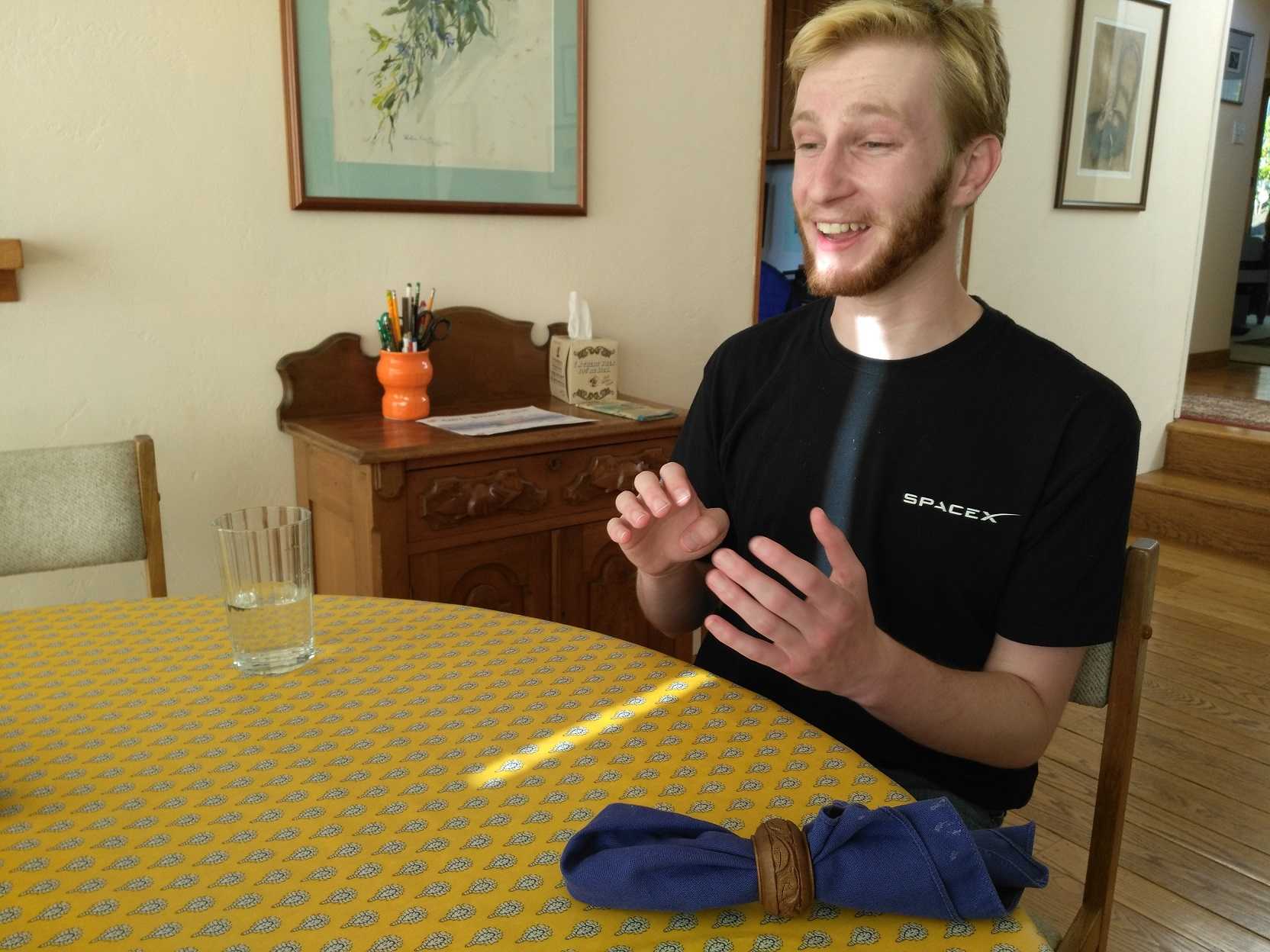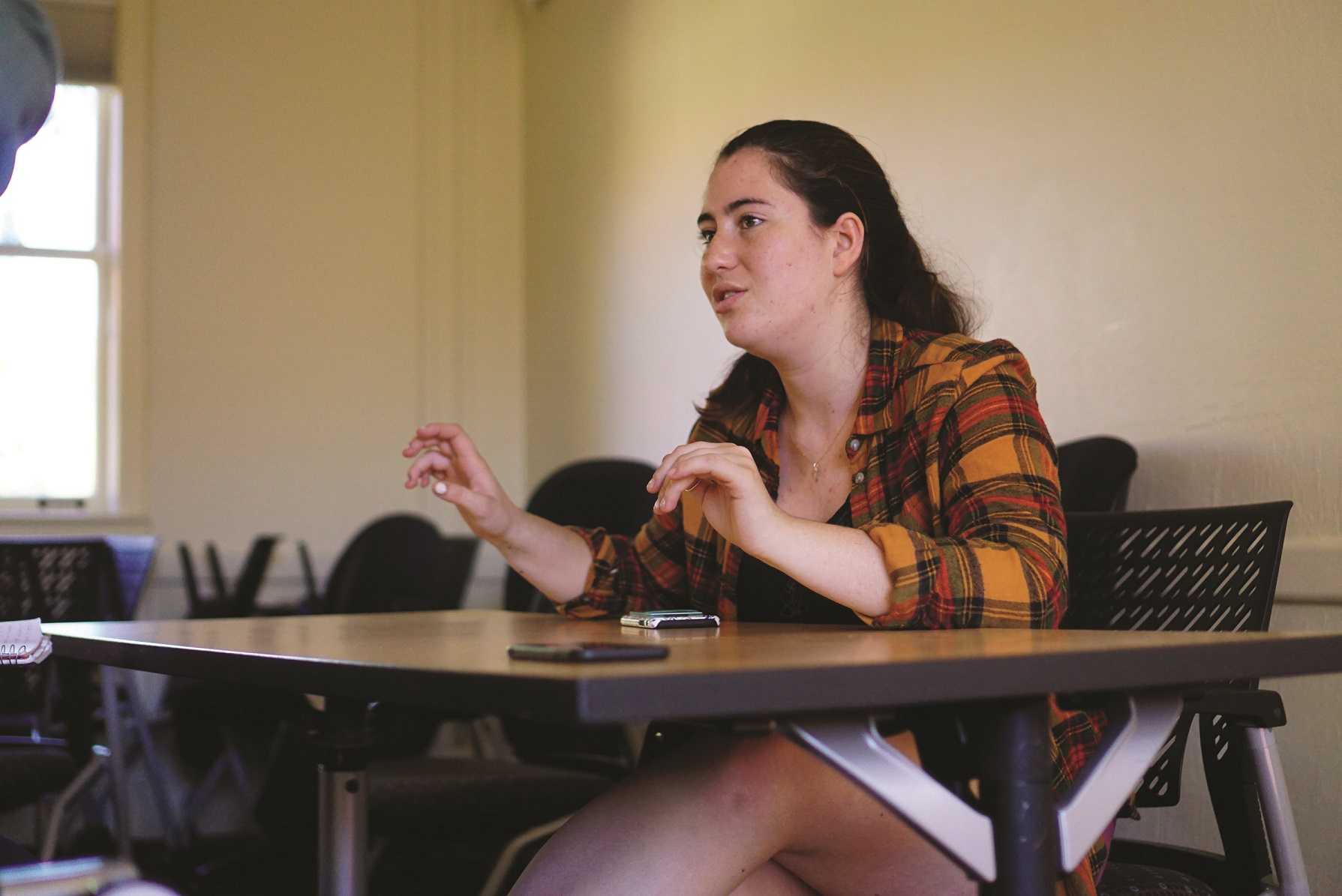Editor’s note: The printing of the October 2018 issue of Veritas was funded by the advertisements found below.
“We arrive at the launch site at about 6 p.m. And of course, nothing works when we get to the launch site. Comms [communications] don’t work, some of the batteries knocked together in the car and had fried, and so we spent hours and hours in the park in the middle of the night just trying to get everything working. At around midnight, the sprinklers go off.”
That’s Kai Marshland speaking. He’s one of two presidents of the Stanford Student Space Initiative, a multi-division organization giving Stanford University students the opportunity to explore the science and ethics of space exploration and research. With expressive hands and an animated storytelling voice, he describes his favorite moment on the team, preparing for a weather balloon launch in a public park in central California.
“And so our table’s sitting here with all of our fancy electronics on it, the sprinkler is rotating, rotating, rotating,” Marshland says, sweeping his outstretched arm in an arc.
Not willing to watch their labor of love be destroyed, the team acted fast, cutting off the offending stream of water — by standing right on top of it.
“At around 3 a.m., we finally launch this thing, and we were exhausted,” Marshland says. “We’re cold, we’re soaked from the sprinklers — just absolutely miserable. We launch this thing? And it works.”

“The payoff for seeing something that you’ve worked so hard on fly, and not only fly, but fly better than [anything] anybody else had ever done? That’s the cool thing,” Marshland says. “That’s the reward.”
Co-president Kai Marshland
Adventures like this are what makes the SSI unique, according to Marshland. One reason he joined was because of the stories he had heard at Stanford’s annual Fall Activities Fair, like a microgravity experiment and a collaboration with the International Space Station. Fellow president Shi Tuck describes a less spontaneous motivation to join.
“I actually read about it [the SSI] in high school, so it was initially on my radar,” Tuck says.
Once she joined, Tuck committed to the satellites subteam, recalling her task of building a flight computer with no electrical engineering experience. The process of learning from square one, she says, was the highlight of her membership on the team.
“It is [was] a really good experience to get my feet wet in the field and also work on actual space hardware,” Tuck said.
Tuck’s journey is that of an archetypal success story. As a girl in an inner city high school, opportunities to explore aeronautics were scant, so she created her own. She propelled model rockets with rocket candy, a solid mix of sucrose as fuel and potassium nitrate as an oxidizer to enable combustion. She educated students on rocketry as founder of her school’s astronomy club. She hosted an event in conjunction with the club to encourage women and minorities to engage with STEM.
The presidents’ stories are two among many in the SSI. They, along with the team leads who agreed to tell their stories, are several stars in a constellation of contrasting personalities, talents and ambitions, which altogether form the self-proclaimed largest project-based student group that Stanford has to offer.
Trajectory to success
A large and aggressively expanding member base is just one privilege that the rockets team enjoys, according to team co-lead Daniel Shorr. He says this is due in part to the team’s broad appeal.
“What is a group that I can go to and feel welcomed? Well, rockets,” Shorr says. “What is a group that I can go to and find a technical challenge? Rockets. What is a group that I can go to … and send stuff to space? Well, that’s rockets.”
According to Shorr, the team’s attempt to develop its first custom, liquid-propellant rocket engine has drawn further interest. They plan to achieve this by launching Helios, a liquid-motor rocket built by non-affiliated graduate students in a Stanford rocketry course. Shorr says the launch, planned for the beginning of the school year, is a major milestone for the team, which has traditionally focused on innovating avionics, aerodynamics and altitude prediction technology — “every part of the rocket except for propulsion,” in Shorr’s own words.
“A lot of students want to go off after they graduate and work for the SpaceXes and Blue Origins and NASAs [National Aeronautics and Space Administration] of the world. … The only way to do that is to have worked on it [propulsion] before. It’s an experience-driven process.”
“It really does feel like we’re in the 60’s and we’re hearing about what the Soviets are doing.”
– Daniel Shorr, rockets team co-lead
The team previously opted for store-bought, solid-propellant rocket motors, consisting of a blend of volatile compounds that, like gunpowder, provide a strong kick when ignited. While solid motors are easy to use and transport, they’re relatively weak.
The transition to liquid propulsion is the SSI’s entry ticket into a race to become the first collegiate rocketry team to send a payload above the 100-kilometer-high Kármán line, representing the divide between Earth’s atmosphere and space. Their self-imposed deadline, the 50th anniversary of the first moon landing, is slightly under a year away on Jul. 16, 2019.
“There’s this kind of low-key space race happening,” Shorr says. “And it’s really cool, because when we’re sitting around discussing this pursuit, there are whispers. Like ‘Oh, what’s Purdue doing?’ ‘Oh, what’s USC doing?’ ‘Oh, you heard this from MIT,’ ‘Oh, Boston University [BU’s rocket] exploded,’ so on and so forth. It really does feel like we’re in the 60’s and we’re hearing about what the Soviets are doing.”
Shorr says the team is as logistically and technically challenging as it is attractive. New members must obtain a standardized rocketry certification from an issuing organization by building and launching their own rockets at one organization’s launch site. Student leadership works intensively with school administrators to ensure that safety measures are robust — especially with regards to liquid propulsion. Furthermore, the propulsion mechanism requires a plumbing system, and the pressurization and composition of fuels and oxidizers have a low tolerance for error.
“Effectively, it means a lot of calculations and a lot of double-checking, triple-checking, and redundancy to make sure that: A, we’re being safe, and B, we’re getting the burn that we want,” Shorr says. “It’s rocket science, through and through. It’s not diet rocket science; it is rocket science.”
Rockets co-lead Daniel Shorr
You can’t rush gene-ius
Phosphoramidite chemistry. Oligonucleotides. Terminal deoxynucleotidyl transferase, or TdT for short.
Cynthia Hao drops these terms and more as she discusses the SSI’s biology team, which she helped captain until this summer. The former Harker School student and Stanford bioengineering major has been with the team since its conception and remains at the forefront of its interdisciplinary effort to build a portable, space-compatible DNA synthesizer. The synthesizer could find use in research aboard space installations as well as the production of biopharmaceuticals, or ingredients for drugs derived from natural processes.
Hao says the current state-of-the art phosphoramidite method, which assembles small DNA sequences one base at a time, sees widespread use in academic and commercial settings. That said, it is not without its flaws.
“That [method] is done unnaturally, it’s done with a bunch of toxic solvents, it’s done in the opposite way that nature does it,” Hao says. “A lot of solvents that are needed for it are really flammable. … We are working on a way to make it water-based, safe, cheap, hopefully a little more efficient and non-toxic, and that actually involves creating our own [DNA synthesis method].”
Cynthia Hao, former biology team co-lead
Other organizations are also pursuing such a method, Hao says, but only the SSI is factoring space transport into the equation. This means that the method must be done autonomously, without relying on gravity and in a small space, in order for it to happen on devices with small payloads. To that end, Biology’s device subteam has developed a device that can carry out the reaction using electrowetting, transporting droplets of fluid that combine and react through voltage-induced movement across hydrophobic pads on a circuit board.
Pioneering and validating the synthesis method itself has been a lengthy process for the team. In the search for a more organic alternative to the phosphoramidite method, they are looking inward, at the enzymes, specifically polymerases, that synthesize DNA in our bodies. Specifically, they rely on TdT for the synthesis of DNA strands without a template — something other polymerases cannot do — and exonuclease T to cut back on the strand.
The team’s method currently works with one nucleotide, but its accuracy, while almost perfect, is not perfect enough. Hao brings up an example of a 99-percent-accurate method used to synthesize 30 nucleotides; the chance of success is 99 to the 30th power, or an unacceptably low 74 percent. Once accuracy is maximized, Hao hopes to eventually publish a research paper. But what comes next?
“That is probably going to be up to the next generation of people,” Hao says. “There’s a lot of really cool projects that people can work on that involve biology and space.”
She lists a couple of ideas, like an aquaponic system to sustain fish and plant life, or a digital-to-biological converter, which turns the idea of creating biopharmaceuticals into reality. But for now, the team is all-hands-on -deck working on their synthesizer — and Hao wouldn’t have it any other way.
“The way we all just work together and flow, and each of us have a job that we’re doing; that feeling is really, really great, and it’s one of the reasons that I’m still here,” Hao says.
“When I got to Stanford, I said ‘I want to find clubs and teams and groups that do stuff similar to what I did at Paly.'”
– Jonathan Zwiebel, balloons team co-lead
What goes up…
“All throughout my four years at Paly, I was part of the Paly Robotics team, and through that team I saw how much I could learn by doing project-based engineering,” says Jonathan Zwiebel, a Paly graduate and sophomore at Stanford. “I had a really good time doing that. And so when I got to Stanford, I said ‘I want to find clubs and teams and groups that do stuff similar to what I did at Paly.’”
His search lead him to the SSI, and his computer science background meant an affinity for the balloons team, over which he soon assumed leadership. One of the team’s objectives, and perhaps the most significant, is to launch payloads carried by high-altitude helium balloons for as long as possible, according to Zwiebel.
This is achieved using a technology called ValBal. A portmanteau of “valve” and “ballast,” the name describes the balloon’s ability to adjust its altitude, increasing altitude by dropping biodegradable pellets (ballast) and decreasing weight, or decreasing altitude by venting helium from a valve. While this allows the balloon to stay 12 to 18 kilometers high for days on end, it doesn’t stay up forever.
“Sometimes we cut it down,” says balloons co-lead Grace Hu, citing international no-fly zones as a reason to end a flight. “Sometimes it just lands naturally after the balloon pops or we run out of ballast, and then we’ll try our best to recover it … otherwise occasionally it lands in the ocean. That is unrecoverable.”
Balloons co-lead Jonathan Zwiebel
In order to guide balloons to recoverable locations, the team is working to develop a modular parafoil, like those on paragliders, called Balloonerang. Hu says Balloonerang steers a spent balloon by means of two motors, which tug on parafoil strings to change its orientation. The latest test was scheduled for Sept. 22, which was cancelled partially due to a global helium shortage, according to Zwiebel.
He adds that ValBal technology, with or without the Balloonerang, is sought after by researchers specializing in the earth sciences: The team has worked with labs to measure glacier depth in Greenland and monitor California wildfires, and are looking forward to a new partnership with the Stanford Research Institute.
But one of Zwiebel’s favorite launches — conceived by Netflix employees at a corporate hackathon — had much lower stakes.
“We had this fantastic payload of this polycarbonate wall with a phone at the background and a camera looking at it, … and we were able to show that this phone was playing Netflix at high altitude,” Zwiebel says. “It was just amazing. You could literally see and hear the video playing and you could see Earth in the background.”
According to Hu, however, the team also has its sights set on more personal achievements.
“We really would like to be able to … potentially circumnavigate the world,” Hu says. “That would be a great combination of a lot of our different subteams for latex enhancement and controls and even Balloonerang.”
Hu says there are other collegiate teams that launch balloons — Columbia and MIT chief among them — but considering that the SSI keeps breaking its own world records for flight time, she is confident about her team’s ability rise above and beyond.
I think, therefore I land
Outsiders may see Chloe Glikbarg’s title of policy lead and assume she lacks STEM expertise. That’s a common misconception, Glikbarg says: as a matter of fact, she studies electrical engineering and spearheads the rocket team’s new propulsion division, in addition to her leadership of the policy team.
“There were a lot of brainstorming sessions on some of the new directions that the policy team could be going towards, and I had a lot of ideas, and people were like ‘alright, you should just be in charge,’” Glikbarg says.
“It’s really important to have … some sort of discussion about what they [engineers] are doing and the doing itself.”
– Chloe Glikbarg, policy team lead
The team’s most immediate focus is a weekly podcast called “This Week in Space,” covering topics from space history to astronomy to industry titans like SpaceX. Glikbarg says the format is somewhat free-form, and often resembles an impromptu conversation more than it does a scripted dialogue.
Chloe Glikbarg, policy team lead
The team is also discussing a possible collaboration with For All Moonkind, a nonprofit advocating for the preservation of moon landing sites as heritage sites. The idea is to turn discussion into action in the form of a proposal to the United Nations Committee on the Peaceful Uses of Outer Space.
“America sticks a flag into the moon and they’re like ‘It’s ours now,’ but, like, what? What does that mean?” Glikbarg asks. “And so … the model convention idea is to create a place for people to come together and talk about things, in the same way that UNESCO is [where] people come together and determine whether places should be preserved.”

The policy team has struggled to recruit and maintain members in the past. Membership went from a single student to eight students this year — an expansion Glikbarg jokingly touts as a 700 percent increase. While that’s still relatively small compared to other teams, Glikbarg doesn’t see the need for the policy team to compete for membership.
“I don’t see the policy team becoming the top priority for a lot of our members, but I also don’t think it should be, because we all joined because we love engineering,” Glikbarg says.
That said, she contends that “it’s good to create balanced engineers. I think it’s really important to have … some sort of discussion about what they [engineers] are doing and the doing itself.”





